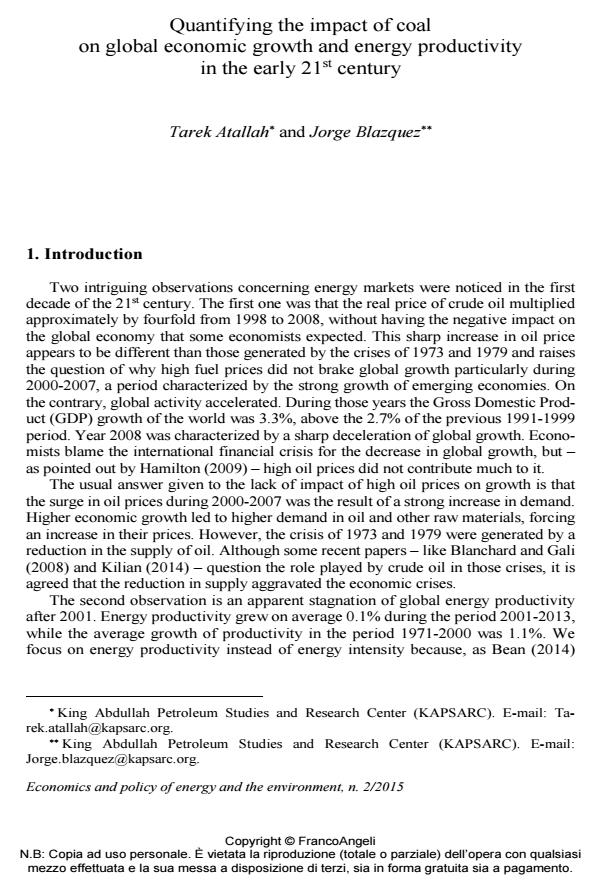Quantifying the impact of coal on global economic growth and energy productivity in the early 21st century
Titolo Rivista ECONOMICS AND POLICY OF ENERGY AND THE ENVIRONMENT
Autori/Curatori Tarek Atallah, Jorge Blazquez
Anno di pubblicazione 2016 Fascicolo 2015/2 Lingua Inglese
Numero pagine 14 P. 93-106 Dimensione file 223 KB
DOI 10.3280/EFE2015-002007
Il DOI è il codice a barre della proprietà intellettuale: per saperne di più
clicca qui
Qui sotto puoi vedere in anteprima la prima pagina di questo articolo.
Se questo articolo ti interessa, lo puoi acquistare (e scaricare in formato pdf) seguendo le facili indicazioni per acquistare il download credit. Acquista Download Credits per scaricare questo Articolo in formato PDF

FrancoAngeli è membro della Publishers International Linking Association, Inc (PILA)associazione indipendente e non profit per facilitare (attraverso i servizi tecnologici implementati da CrossRef.org) l’accesso degli studiosi ai contenuti digitali nelle pubblicazioni professionali e scientifiche
Two intriguing circumstances have characterized the behavior of energy markets in the first years of 21st Century: a sharp increase in oil prices without a clear impact on real economic activity and a relative stagnation of energy productivity after 30 years of continuous improvement. This paper uses a standard macroeconomic production function to show that these two circumstances are consistent with sharp global increase in coal production and consumption. Our results suggest that the strong shift in coal production in the period 2000-2007 can explain why the sharp increase in oil prices did not impact negatively global activity and a relative stagnation in energy productivity. In addition, the paper also highlights the shift in the energy mix towards coal and natural gas and alerts that these fuels, and not only crude oil, can be sources of macroeconomic shocks in the future.
Keywords:Coal, oil, natural gas, fossil fuels, energy productivity, economic growth
Jel codes:Q41, Q43, O40
- Acurio-Vásconez V. and Giraud G. (2012). Energy and Capital in a New-Keynesian Framework. Documents de Travail du centre d’Economie de la Sorbonne, 92.
- Bernanke B.S., Gertlet M. and Watson M. (1997). Systematic Monetary Policy and the Effects of Oil Price Shocks. Brookings Papers on Economic Activity, 91-157. DOI: 10.2307/2534702
- Bean P. (2014). The Case for Energy Productivity: It’s Not Just Semantics. KAPSARC Discussion Paper KS-1402-DP01B. Available at SSRN: http://ssrn.com/abstract=2419821 or http://dx.doi.org/10.2139/ssrn.2419821.
- Blanchard O.J. and Gali J. (2008). The Macroeconomic Effects of Oil Price Shocks: Why Are the 2000s so Different form 1970s? In Gali J. and Gertler Mark J. (Eds.). International Dimensions of Monetary Policy. University of Chicago Press.
- Burniaux J. and Truong P. (2002). GTAP-E: An Energy-Environmental Version of the GTAP Model. GTAP Technical Paper No. 16.
- De Miguel C., Manzano B. and Martin-Moreno J.M. (2003). Oil Price Shocks and Aggregate Fluctuations. The Energy Journal, 24 (2): 47-61. DOI: 10.5547/issn0195-6574-ej-vol24-no2-2
- De Miguel C., Manzano B. and Martin-Moreno J.M. (2006). Oil Shocks and the Business Cycle in Europe. In de Miguel C., Labandeira X. and Manzano B. (eds.). Economic Modelling of Climate Change and Energy Policies. Edwar Elgar Publishing.
- Durand-Lasserve O., Pierru A. and Smeers Y. (2010). Uncertain Long-Run Emissions Targets, CO2 Price and Global Energy Transition: a General Equilibrium Approach. Energy Policy, 38: 5108-5122. DOI: 10.1016/j.enpol.2010.04.041
- Eastwood R.K. (1992). Macroeconomic Impacts of Energy Shocks. Oxford Economic Papers: 403-425.
- Energy Information Administration (2015). Average Operating Heat Rate for Selected Energy Sources. http://www.eia.gov/electricity/annual/html/epa_08_01.html.
- Energy Information Administration (2012). Fuel Competition in Power Generation and Elasticities of Substitution. Independent Statistic and Analysis, June.
- Golosov M., Hassler J., Krusell P. and Tsyvinski A. (2014). Optimal Taxes on Fossil Fuel in General Equilibrium. Econometrica, 82 (1): 41-88. DOI: 10.3982/ecta10217
- Hamilton J.D. (1983). Oil and the Macroeconomy Since World War II. The Journal of Political Economy, 91 (2): 228-248. DOI: 10.1086/261140
- Hamilton J.D. (2009). Causes and Consequences of the Oil Shock of 2007-08. Brookings Papers on Economic Activity, Spring. DOI: 10.3386/w15002
- Hickman B., Huntington H., Sweeney J. (Eds.) (1987). Macroeconomic impacts of energy shocks. Amsterdam: North-Holland.
- International Energy Agency (2011). Emissions from Fuel Combustion.
- International Energy Agency (2014). Energy Efficiency Market Report.
- Kilian L. (2008). The Economic Effects of Energy Price Shocks. Journal of Economic Literature, 46, 4: 871-909. DOI: 10.1257/jel.46.4.871
- Kilian L. (2009). Not All Oil Price Shocks are Alike: Disentangling Demand and Supply Shocks in the Crude Oil Market. The American Economic Review, 99 (3): 1053-1069. DOI: 10.1257/aer.99.3.1053
- Kilian L. (2014). Oil Price Shocks: Causes and Consequences. CEPR Discussion Paper, No. DP9823.
- Leduc S. and Sill K. (2004). A Quantitative Analysis of Oil-Price Shocks, Systematic Monetary Policy, and Economic Downturns. Journal of Monetary Economics, 51 (4): 781-808.
- Rose A.K. and Spiegel M. (2012). Cross-Country Causes and Consequences of the 2008 Crisis: Early Warning. Japan and the World Economy, 24 (1): 1-16. DOI: 10.1016/j.japwor.2011.11.001
- Stern D.I. (2012). Interfuel Substitution: A Meta-Analysis. Journal of Economic Surveys, 26 (2): 307-331. DOI: 10.1111/j.1467-6419.2010.00646.x
- Comparing Renewable Energy Policies in E.U.15, U.S. and China: A Bayesian DSGE Model Amedeo Argentiero, Tarek Atalla, Simona Bigerna, Silvia Micheli, Paolo Polinori, in The Energy Journal /2017 pp.77
DOI: 10.5547/01956574.38.SI1.aarg
Tarek Atallah, Jorge Blazquez, Quantifying the impact of coal on global economic growth and energy productivity in the early 21st century in "ECONOMICS AND POLICY OF ENERGY AND THE ENVIRONMENT" 2/2015, pp 93-106, DOI: 10.3280/EFE2015-002007